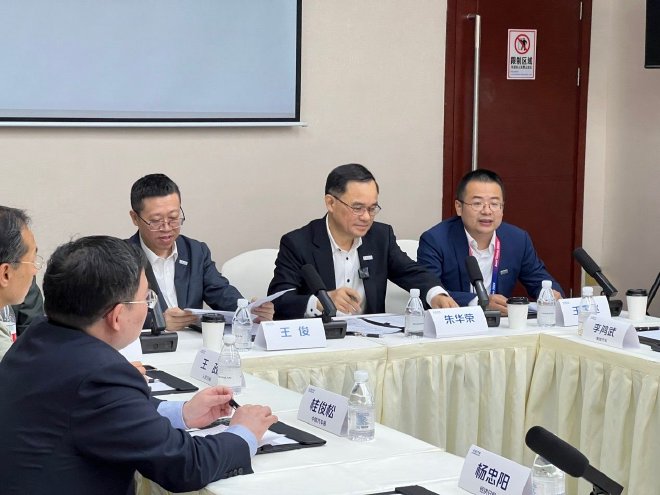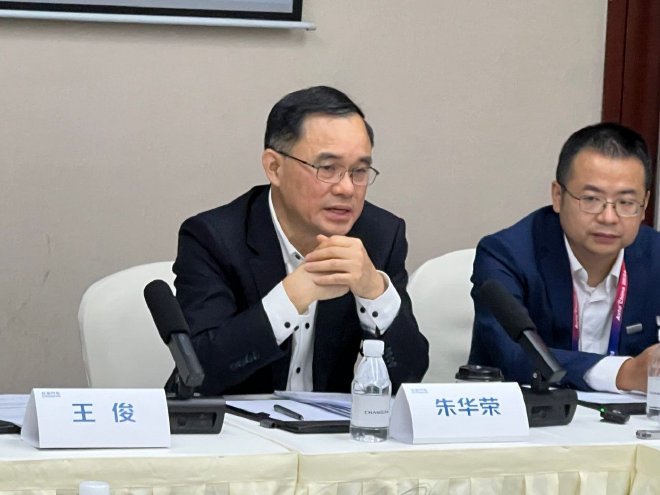The 2024 Beijing Auto Show was enveloped in a “torrent of traffic”, how did the car companies at the center of the “whirlpool” cope? For this question, it is not difficult for car companies with their own traffic like Xiaomi, NIO, XPeng, Li Auto, and Jidai to handle. But for traditional car companies, facing the new marketing ecosystem, not making efforts to change, they will really be eliminated. In this situation, few car companies “sit still” and do not actively attack in marketing. In the fiercely competitive car market, those seasoned leaders of the main factories have long embarked on a new “journey”, moving from behind the scenes to the forefront, “landing first” on platforms such as Weibo and short videos to promote the company. Therefore, we see at the Beijing Auto Show, Changan Automobile Chairman Zhu Huarong picked up a selfie stick and started live streaming, while President Wang Jun shot short videos, promoting Changan Automobile’s products and technology with 5-6 Weibo updates per day. Creating value for customers is the long-term traffic for companies. Regarding the rapid new communication changes made by Changan Automobile, Zhu Huarong said at the media briefing at the 2024 Beijing Auto Show, “Even good wine needs to be promoted, without promotion, it won’t work.”
Compared to waiting a month for sales data on a new car, the real-time results brought by new communication are more rewarding. Zhu Huarong sees the possibility of becoming like Lei Jun and Yu Chengdong through short videos and live streaming data. He believes that traffic is the productivity of future leaders and must be unleashed. When automotive executives do live broadcasts and play on Weibo, they not only increase the visibility of their companies but also engage with users more closely. Zhu Huarong sees more than just data in the “revolution” of marketing for a conglomerate – he sees sharp comments from users. Zhu Huarong believes in the importance of paying attention to details pointed out by users. As business leaders reap the benefits of traffic and drive rapid transformation in marketing, they also face greater challenges. In the past, being a “good student” in car manufacturing was enough, but now, every employee at an OEM must be an “all-around champion.” They must excel in product development, understand technology, and excel in channel construction. Zhu Huarong emphasizes the need for business leaders to focus on traffic. Changing the way of communication is urgent, but it is crucial to differentiate between short-term and long-term traffic. Lei Jun and Yu Chengdong, with their personal IP traffic in the consumer electronics field, excel in creating buzz in the automotive industry, a strength that traditional automakers lack in their transformation. Short-term traffic should not be seen as the core of product promotion or brand marketing. Changan Automobile is committed to a long-term flow route centered on users, creating product value and service value. Changan Automobile’s Zhu Huarong stated, “Enhancing long-term sustainable flow, rather than fleeting forms and states.” Changan Automobile’s long-term flow includes two aspects: one from a technology-based development path, and the other from the group’s profit targets. Changan Automobile has always been a technology-based enterprise with a deep foundation, boasting 180 laboratories and a large amount of standardized, platform-based databases. This has achieved the baseline of Changan’s new energy security, such as the Jinzhongzha battery being able to achieve zero heat loss, no smoke, and no fire. Changan Automobile will also focus on products, providing users with the most valuable products. Zhu Huarong stated, “The biggest change brought by technology is the democratization of high technology.” Changan Automobile, as a listed company, needs to develop according to the demands of major shareholders of listed companies, adhering to the requirements of value investment and organic balance of current profits. Changan Automobile must not only improve in profit indicators but also in the value or valuation of sectors or brands. Grasping the balance of “involution” relies on digital intelligence. The “involution” of the Chinese automobile market tests the operations, strategies, and goals of main manufacturers. Changan Automobile also faces challenges from all aspects of “involution.” During the pursuit of balanced development, Zhu Huarong revealed that Changan Automobile still focuses on the user as the core. The products should not only consider price factors but also cater to the current consumer trends. The models should have high appearance and technology, enhance intelligence, free both feet and eyes, and even the brain. The enjoyment of driving should be experienced in the intelligent cockpit. Facing faster product development, Changan Automobile must balance quality and cost. Changan Automobile has fully utilized the efficiency improvement of “one library and three data intelligences” by using a large number of developed databases. For example, the intelligent factory has created a 5G+wifi6 scene, with a downlink bandwidth of 1G and an uplink bandwidth of 168 megabytes. A complete sequential filling of a car can be completed in 3 to 5 minutes, which used to take one to two hours. This kind of data intelligence has been applied to the three brands under Changan Automobile. Zhu Huarong said, “With new technologies, efficiency has increased by about 20%, costs have decreased by 20%, and carbon emissions have been reduced by 19%. This is the future that new technologies bring us in terms of balancing cost reduction and efficiency improvement.” The competitiveness of new energy vehicles is determined by the price of vehicles with similar attributes. A large part of the competition in the Chinese car market comes from the pricing of vehicles. According to market economic laws, intense competition will inevitably lead to the exit of companies, gradually increasing the industry’s concentration. How will price wars affect the future of Changan Automobile? Changan Automobile President Wang Jun believes that no matter the intensity, breadth, or strength, as long as there is a supply-demand conflict, competition will arise. The most effective or quickest way to adjust is through pricing. He said, “So far, the adjustment of this supply-demand conflict has not ended.” As for the price competition of new energy vehicles, products with the same configuration and attributes will result in substitution. Wang Jun said, “It must be more competitive in terms of price.” The price of compact sedans is still in the range of 80,000 to 100,000. If new energy vehicles cannot reach this price, their chances of winning in competition will significantly decrease. We need to find competitive pricing methods, such as improving efficiency and reducing costs, or achieving a basic balance between capital costs and returns. Changan Automobile has found the answer in the Qiyuan brand. This brand transcends the boundaries of traditional categories and provides consumers with a new pricing rule. This reflects the new supply relationship provided by new energy and intelligence for the future of the Chinese automotive industry. Wang Jun of Changan Automobile said, “I am confident in the Chinese automotive industry. Through continuous competition and innovation, we can meet consumers’ new demands and achieve a Chinese-style supply-demand balance.” Deep evolution of the Deep Blue brand Almost all executives of major automakers knew immediately about the 80,000 orders obtained by Xiaomi SU7 after its release. At the Changan Automobile media communication meeting, Zhu Huarong and Wang Jun also mentioned this. In fact, the cumulative number of users of the Deep Blue brand under Changan has exceeded 200,000 in two years, indicating that the brand has successfully established brand awareness and supply relationships. Regarding the Deep Blue brand, enhancements have been made on the service side and in new marketing aspects. Orders, deliveries, and maintenance services are separated, allowing for home test drives like new forces, one-click orders on the app, home delivery of new cars, and other services. Wang Jun said, “I believe that the automotive industry is a long-term industry. Brands, scenarios, and the ability to continuously provide high-value services are very important to consumers.” At this year’s Beijing Auto Show, Deep Blue also announced its product plan for the year, which will include the launch of three models: the G318 model, the C857 model, and another model that was not disclosed during the communication meeting. Complementary Globalization with Mazda Changan Mazda unveiled the all-electric model Changan Mazda EZ-6 at the Beijing Auto Show, integrating Changan’s new energy technology with Mazda’s innovations in electrification, intelligence, design, handling, and safety. Changan’s Chairman Zhu Huarong stated, “We join forces with Mazda to combine Mazda’s precise grasp of the brand and global market with Changan’s platform and technology, addressing issues in both the Chinese and global markets. This is a complementary approach to tackle global market challenges.” This cooperation model should be considered by every Chinese car company in the fierce competition of the Chinese automotive market, especially in intelligence and electrification. Each company will choose the most suitable development path, such as leading platform development, technology development, product launches, and global integration, or trying to hold shares or acquire Chinese companies. By 2030, Changan aims to become a world-class automotive brand. Changan aims to become a world-class car brand by 2030 or earlier, with a target of 4 million vehicles to enter the top 10 among Chinese domestic brands. Changan will offer a variety of vehicle types, including fuel, electric, hybrid, and extended-range models, as well as commercial vehicles, for global users to choose from. Changan’s Zhu Huarong stated, “It is unrealistic to stop selling fuel vehicles. We must be practical and acknowledge the demand in the global market, as well as from Chinese consumers. We need to manage our inventory of fuel vehicles accordingly.”

